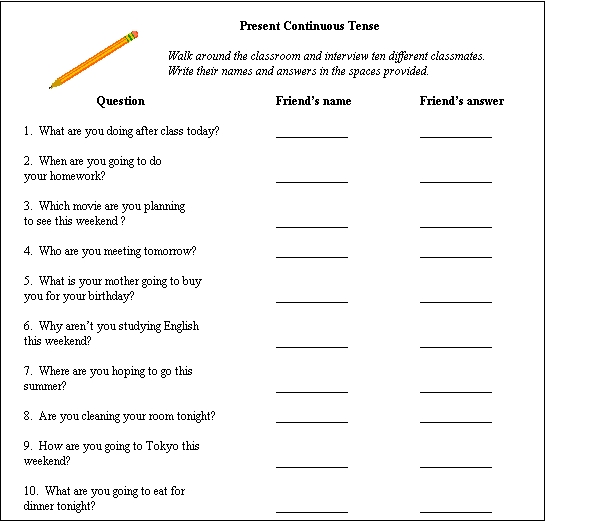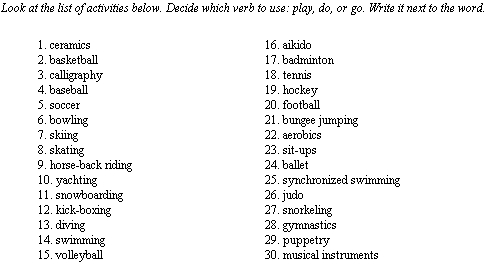QUICK GUIDE
- Key Words:Customer, fortuneteller, future
- Learner English Level: Low to intermediate
- Learner Maturity Level: High school
- Preparation Time: 15 minutes
- Activity Time: Two class periods, for the entire lesson
- Materials: Blackboard, copies of worksheets
Introduction:
Most young people are interested in what the future holds for them. High school students, in particular, are curious about what kind of lives they will lead after they graduate from school. They often wonder, Am I going to be able to get a good job? or Am I going to be successful? They ponder whether they will be able to meet the loves of their lives or not, or if they will be happy. In response to students' desires to talk about their futures, I have found that using a fortune telling activity enables students to have fun with their friends by guessing what kind of future is in store for them, while at the same time building on their fluency to use the present continuous tense to talk about future plans.
Procedure:
Before beginning the focus activity, it is important that the teacher reacquaint the students with the target language so that they understand the purpose of the lesson and gear themselves towards using the correct grammatical patterns. The teacher may then want the students to do an additional short activity as a lead up to the main activity of fortune telling.
It will then be time for students to role-play a situation between a customer and a fortuneteller. Here, using the present continuous tense, the customer can ask about his/her future. For example, Where am I going to work after I finish school? or Am I going to be happy? It is important to stress to the students that both the customer and the fortuneteller will need to use the target language and to use complete sentences while doing so.
The teacher should write the following on the board and explain how the present continuous is used to talk about the immediate future.
Pattern 1:
am
is + Verb-ing
are
Pattern 2:
am
is + Verb-ing + to Verb
are
Step 2: After giving a few examples, the teacher should ask a few questions to random students to generate simple answers using one of the above grammatical patterns.
Step 3 (Optional): Interview activity. Distribute worksheet with 10 questions using the present continuous tense (see Figure 1). Have the students move around the classroom asking and answering questions. Encourage the students to speak only English and to make sure that they interview 10 different people in the classroom. Once the activity is finished, have the students report the answers that they received back to the class. Write one answer for each question on the board. Then have the students repeat the answers for pronunciation and intonation practice.
Figure 1: Interview activity

Step 4: Put students into pairs.
Step 5: Distribute copies of the "Look into the Crystal Ball" worksheet.
Figure 2: Look Into the Crystal Ball
| Fortune Teller | Customer | |
|
Welcome. I am going to look into my crystal ball to see your future. Ask me any question you like. |
|
Okay. Where am I going to work after I finish school? |
| You are going to work at (name of any company) in (name of any city). | (name of that city) ???? Really? Am I going to move to (name of that city)? | |
| Yes, you are going to move to (name of that city) after you meet the love of your life. | What? Am I going to meet a (adjective) and (adjective) person? | |
| You are going to fall in love with a (adjective) and (adjective) (man or woman). | Wow! That’s great! When am I going to meet them? | |
| You are going to meet them (number) years from now. | And am I going to have lots of children? | |
| Yes, you are going to have (number) children. | I see. Am I going to make enough money to support my children? | |
| Yes, you are going to make lots of money, about (large number) dollars a month. | Oh, I am so excited. But, am I going to be happy? | |
| Yes, you are going to be happy, (adjective), and (adjective). | Oh, thank you very much. Goodbye. | |
| Hey, what about my money? | Oh, here's ______ yen. |
Step 6: Have students decide between themselves who will be the first customer and who is going to be the fortuneteller.
Step 7: Explain to the students that the fortuneteller will have to be creative and to use imagination in filling in the missing blanks on the worksheet. Encourage them to have fun.
Step 8: Provide students with an example of filling in the gaps by you, the teacher, role-playing the first couple of lines by yourself.
Step 9: Encourage students who finish early to change roles and do the exercise again. Encourage stronger students to create their own questions and answers for fortune telling.
Step 10: Once all students have completely finished the activity, have volunteers role-play their situations in front of the entire class.
Step 11: The teacher should correct errors as each team does their role-play.
Follow-up:
If more practice is needed for the present continuous tense, the teacher can ask students, as a class, about their favorite leisure time activities. Then, with the students in groups of three or four, have them complete the task in Figure 3. They must agree as to which verb is more appropriate for each activity: do, go, or play.
Figure 3: Do, go, or play?

Check the answers as a class. Then have students make original dialogues. The teacher can present an example like the one here:


